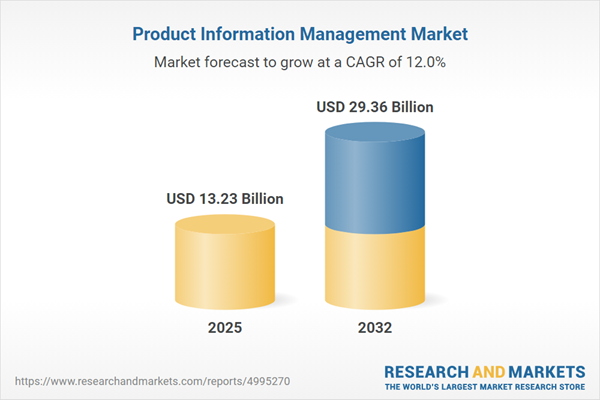Speak directly to the analyst to clarify any post sales queries you may have.
Product Information Management (PIM) solutions are becoming an integral part of enterprise technology strategies, enabling organizations to streamline processes, support compliance, and adapt confidently to increasingly complex regulatory and digital landscapes. As enterprises strive for operational consistency and resilience, PIM platforms deliver centralized oversight and efficient collaboration across global operations.
Market Snapshot: Product Information Management Market
The global Product Information Management market is witnessing sustained growth as senior leaders prioritize robust digital infrastructure and omnichannel readiness. With a current market valuation of USD 11.81 billion and a projected reach of USD 13.23 billion by 2025, the sector is advancing at a 12.04% CAGR. This momentum is underpinned by surging demand for sophisticated data automation, secure product content accessibility, and responsive compliance. Businesses are leveraging unified PIM platforms to facilitate transparent data flows, streamline risk management activities, and fulfill evolving regulatory and customer demands. The market’s expansion is further driven by diversified industry needs, increasing the call for scalable and adaptable solutions.
Scope & Segmentation of the Product Information Management Market
A detailed view of PIM market segmentation helps senior decision-makers align technology investments with digital transformation and enterprise risk mitigation objectives. Structured segmentation provides clarity for selecting appropriate tools and approaches for organization-wide compliance and operational advancement.
- Component: Consulting, deployment support, maintenance, software licensing, and technology upgrades form the foundation for resilient, iterative PIM implementation and optimization.
- Deployment Model: Private cloud, public cloud, hybrid, and on-premise frameworks allow organizations to adjust adoption strategies as operational requirements and regulatory contexts change.
- Industry Vertical: Sector-focused solutions address distinct business needs, such as catalog management for retailers, regulatory focus for BFSI, compliance tracking in healthcare, and more streamlined manufacturing processes.
- Organization Size: Comprehensive platforms serve both large enterprises demanding intricate governance and SMEs prioritizing cost-effective scalability and workflow control.
- Application: Usage encompasses analytics, reporting, governance, catalog management, data quality assurance, and workflow automation, equipping organizations to refine processes and maintain regulatory adherence.
- Geographical Coverage: Adoption patterns differ across the Americas, Europe, Middle East & Africa, and Asia-Pacific, shaped by infrastructure maturity and distinct compliance needs in each region.
- Key Providers: Prominent vendors include Informatica LLC, Oracle Corporation, SAP SE, IBM Corporation, Stibo Systems A/S, Salsify Inc., Akeneo SAS, Riversand Technologies Inc., inRiver AB, and Pimcore GmbH, all offering adaptable platforms to accommodate enterprise evolution.
Key Takeaways for Senior Decision-Makers
- PIM solutions unify product data management, breaking down silos and ensuring coordinated collaboration for globally dispersed teams.
- Automation and artificial intelligence components deliver measurable operational efficiencies, empowering businesses to address shifting compliance obligations promptly and effectively.
- Built-in audit features support visibility and transparency, easing compliance efforts and strengthening risk management across dynamic regulatory environments.
- Flexible architecture enables organizations to modify IT deployment strategies to stay current with business model changes and regulatory shifts.
- Vertical-specific functionalities help maintain governance standards and support targeted digital initiatives for sustained process improvement.
- Leadership teams benefit from advanced analytics and comprehensive governance mechanisms, ensuring effective oversight even as markets and requirements evolve.
Tariff Impact: Market and Workflow Adaptations
Forthcoming U.S. tariff changes in 2025 will require organizations to refine their supply chain visibility and compliance processes. Modern PIM platforms enable real-time tracking of shifting regulations, enhance sourcing and distribution workflows, and simplify operational cost management as tariffs adjust. These capabilities help mitigate the direct and ancillary risks associated with fluctuating tariff environments, strengthening operational resilience in the face of regulatory change.
Methodology & Data Sources
This analysis draws on direct input from executive interviews, detailed financial benchmarks, and established industry practices. Market insights are continuously updated through ongoing monitoring, ensuring executives receive accurate, actionable intelligence to support digital growth and compliance.
Why This Report Matters
- Equips executive teams to enhance compliance, streamline governance, and drive critical digital transformation objectives throughout the organization.
- Provides impartial benchmarking for technology investment and localized market planning, supporting informed and strategic decision-making.
- Supplies actionable perspectives on regulatory management and digital innovation to reinforce operational resilience and enable proactive change management.
Conclusion
This report offers senior leaders a practical framework to accelerate digital advancement, bolster operational reliability, and maintain PIM strategies aligned with both compliance requirements and organizational growth targets.
Additional Product Information:
- Purchase of this report includes 1 year online access with quarterly updates.
- This report can be updated on request. Please contact our Customer Experience team using the Ask a Question widget on our website.
Table of Contents
3. Executive Summary
4. Market Overview
7. Cumulative Impact of Artificial Intelligence 2025
Companies Mentioned
The companies profiled in this Product Information Management market report include:- Informatica LLC
- Oracle Corporation
- SAP SE
- IBM Corporation
- Stibo Systems A/S
- Salsify Inc.
- Akeneo SAS
- Riversand Technologies Inc.
- inRiver AB
- Pimcore GmbH
Table Information
| Report Attribute | Details |
|---|---|
| No. of Pages | 193 |
| Published | October 2025 |
| Forecast Period | 2025 - 2032 |
| Estimated Market Value ( USD | $ 13.23 Billion |
| Forecasted Market Value ( USD | $ 29.36 Billion |
| Compound Annual Growth Rate | 12.0% |
| Regions Covered | Global |
| No. of Companies Mentioned | 11 |









